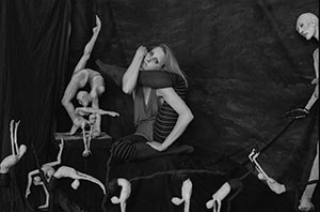Born 1958, Detroit, Michigan
Died 1996, Chicago, Illinois
Greer Lankton is best known for her meticulously fabricated dolls: a motley, marginal cast of characters that includes circus performers and friends alongside the fashion elite. Lankton, who began making dolls as a child, earned a degree in sculpture from Pratt Institute, New York, in 1981. While a student, she underwent gender reassignment surgery, and her work reflects an enduring interest in the mutability and fragility of the body. Making her debut in the landmark exhibition New York / New Wave in 1981 at PS1, Lankton became a fixture of the East Village art scene. But wrestling with drug addiction, she left the city in 1987. Shortly before her untimely death, she was included in both the Whitney and Venice biennials.
Lankton approached the body as a site of constant metamorphosis. Sometimes grotesque, often glamorous, her dolls are built up from soda cans, tape, wire, paper, plaster, and stockings and finished with realistic glass eyes. From Diana Vreeland to Divine, her pantheon of muses and misfits includes subjects of identification, kinship, and camp enthusiasm. With spindly limbs and sucked-in figures, many resemble the gaunt figures of Egon Schiele, while others are soft and swollen. The artist subjected the dolls to perpetual change, switching their outfits, genders, and body types. The flux and undeniable drama of her oeuvre are accentuated in remarkable photographs that insert her creations into intimate yet theatrical scenes.
In a suite of narrative watercolors, Lankton envisioned gender transition as a process of change unfolding in time, representing the tender and traumatic memory of her own operation. An early work, Rags, evokes the body as unformed, barely articulated by string bindings and smudges of paint, while Immolated Skin conjures a deformed, dismembered body. By contrast, dolls depicting Candy Darling and Jackie O. are exquisitely finished: the Warhol superstar is coiffed, bedecked, and immaculately nude; the former First Lady is clad in handsewn Chanel, her expression pinched to the point of caricature. Polaroid snapshots lend the Jackie O. doll a stagy interiority, while frozen moments in the “lives” of some of Lankton’s other creations are hauntingly captured in black-and-white photographs. Such photographic proximity heightens the emotional charge of the mannequinlike dolls without bridging their uncanny, remote appearance.
Jenevive Nykolak
Durbin, Andrew, and Paul Monroe. “Unalterable Strangeness—Greer Lankton.” Flash Art, no. 301 (March–April 2015): 94–103.
Goldin, Nan. “Greer Lankton.” Artforum 38, no. 2 (October 1999): 125, 161–162.
King, Margery. “Greer’s World.” GLQ: A Journal of Lesbian and Gay Studies 9, no. 4 (2003): 557–563.
